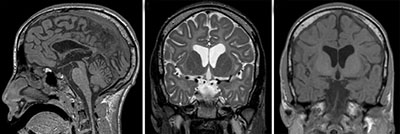
Kawashima Tsuji syndrome, or Microcephaly-deafness-intellectual disability syndrome, or simply Microcephaly-deafness syndrome, is an extremely rare genetic disorder characterized by microcephaly, deafness, intellectual deficit, speech delay, short height, and facial dysmorphism that includes facial asymmetry, prominent glabella, low-set and cup-shaped ears, protruding lower lip, and micrognathia.
The disorder was discovered by researchers H. Kawashima and N. Tsuji in 1987, reporting only 2 cases of this disorder — a mother and her son — back then.
Synonyms: Microcephaly-hearing loss-intellectual disability syndrome, Microcephaly-deafness syndrome, Microcephaly-deafness-intellectual disability syndrome
Signs and Symptoms
- Microcephaly
- Congenital hearing loss
- Intellectual disability
- Speech delay
- Short height
- Low-set cup-shaped ears
- Protruding lips
- Micrognathia
- Epicanthal folds
- Drooping lower lip
- Big distance between the eyebrows
Prevalence
< 1 / 1,000,000
Age of Onset
Infancy, Neonatal
Diagnosis
- Physical examination: A doctor will assess the individual's physical features, including the head size, facial characteristics, and any other potential malformations.
- Medical history: Family history and information about the individual's development and any present symptoms.
- Genetic testing: Though the specific genetic cause is yet to be identified, genetic testing may be helpful in some cases to rule out other possibilities.
Nursing Interventions
- Monitoring and assessment: Regularly monitor the child's growth, development, and overall health. Keep track of head circumference measurements to assess for changes in microcephaly. Monitor hearing status and provide appropriate interventions if hearing loss is present.
- Developmental support: Provide developmental stimulation appropriate for the child's age and abilities. Encourage activities that promote motor, cognitive, and social development.
- Communication support: For children with hearing loss, consider the use of sign language, hearing aids, or other communication devices to facilitate communication. Provide resources and support to the family to help them communicate effectively with the child.
- Feeding support: Some children with Kawashima Tsuji syndrome may have feeding difficulties. Provide support and guidance to ensure adequate nutrition and hydration.
- Seizure management: Some individuals with microcephaly deafness syndrome may experience seizures. Monitor for seizure activity and provide appropriate care as needed.
- Family support: Provide emotional support and education to the family about the syndrome, its management, and available resources. Encourage the family to seek support from other families or support groups for individuals with similar conditions.
- Health promotion: Encourage healthy lifestyle habits, such as regular physical activity and a balanced diet, to promote overall health and well-being.
- Coordination of care: Work collaboratively with other healthcare providers, therapists, and specialists involved in the child's care to ensure comprehensive and coordinated care.
